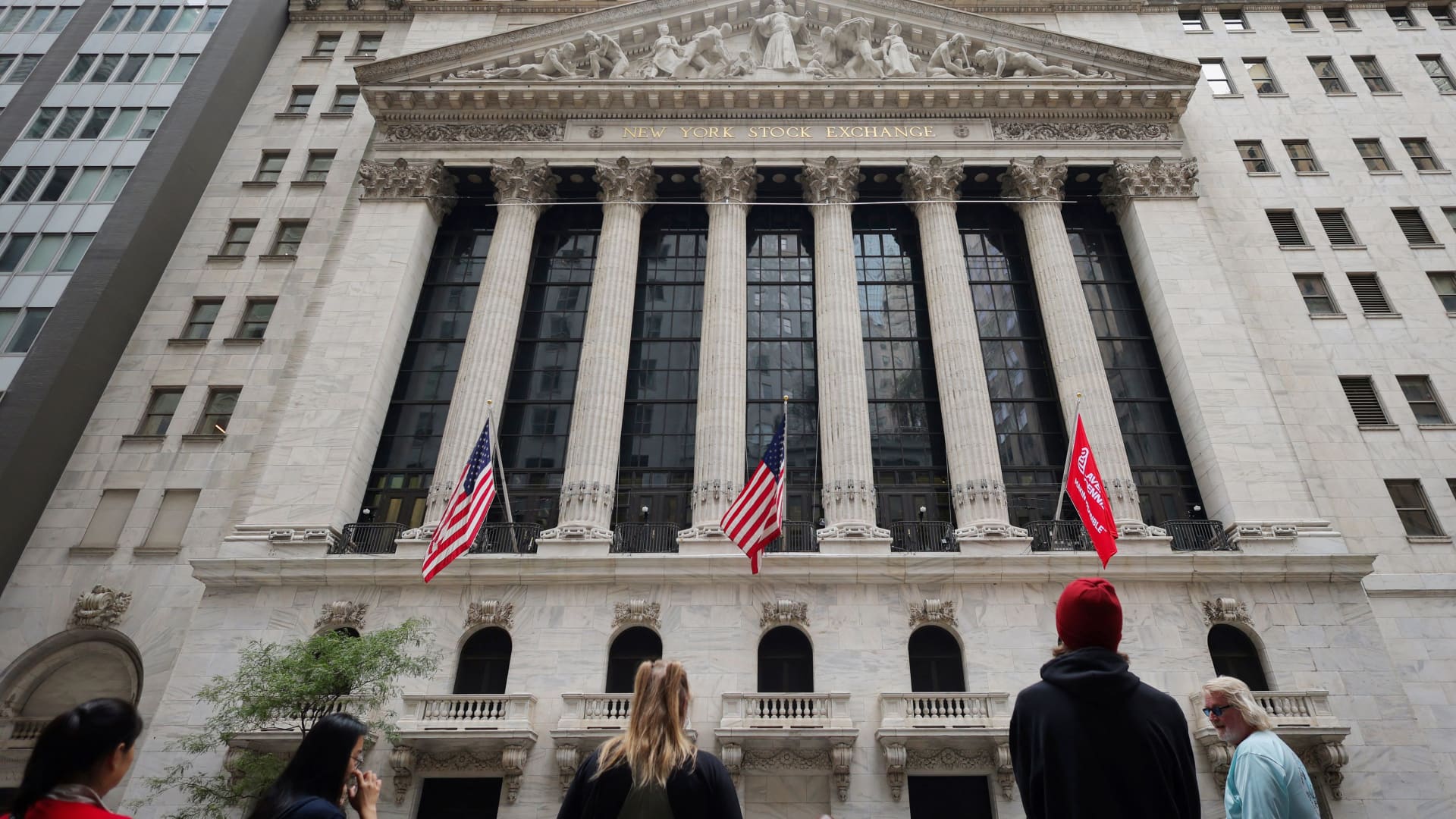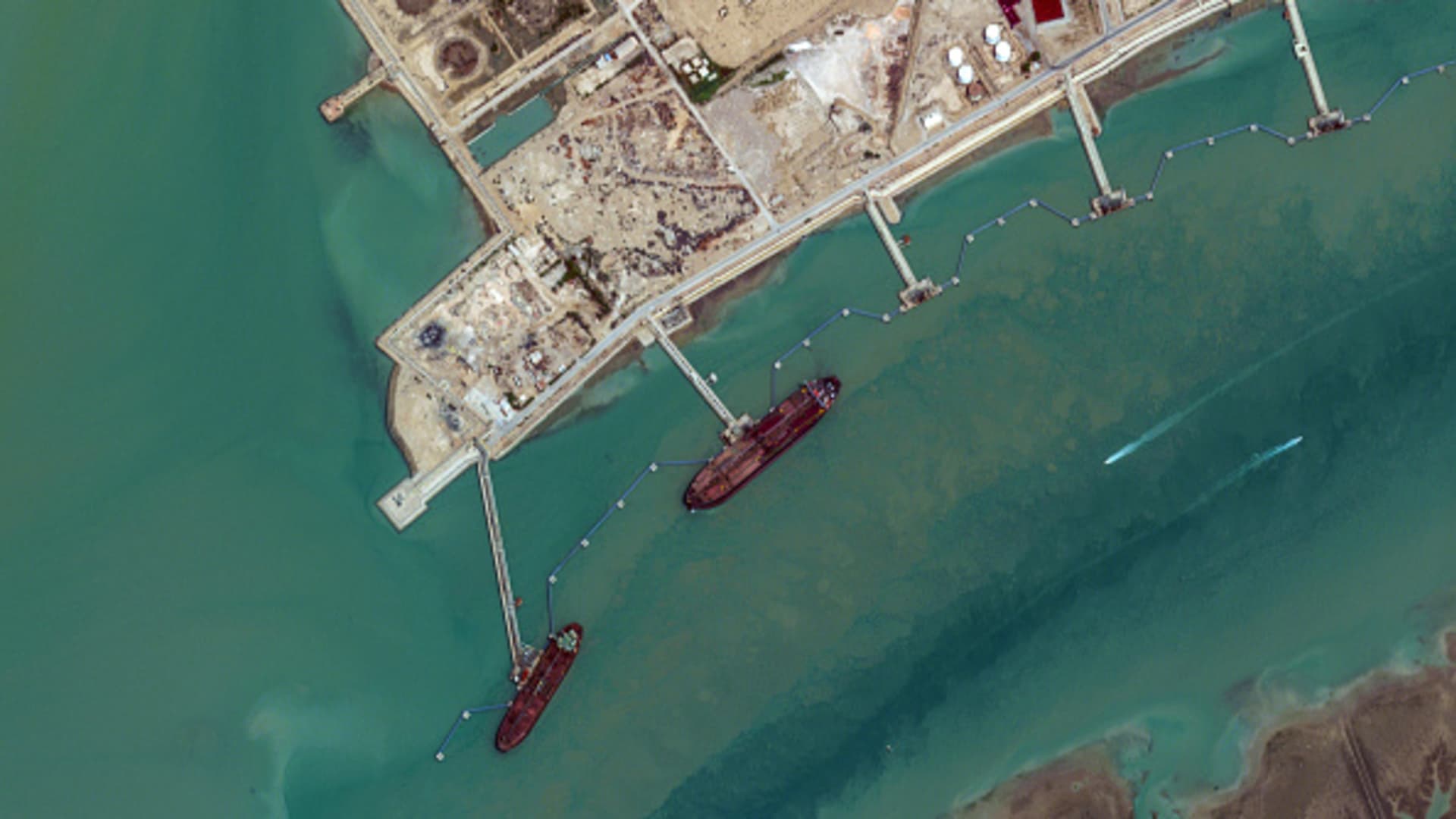Science & Environment
Nvidia bucks the market, and oil jumps on fears of how Israel may respond to Iran’s missile attack

Every weekday, the CNBC Investing Club with Jim Cramer releases the Homestretch — an actionable afternoon update, just in time for the last hour of trading on Wall Street.
Science & Environment
Rare brightening comet seen passing Earth from Hawaii

A telescope in Hawaii captured a rare comet as it passes near Earth. The footage was captured on 2 October by the National Astronomical Observatory of Japan’s Subaru-Asahi Star Camera on the summit of Maunakea.
Comet Tsuchinshan-ATLAS was discovered in January 2023 after Tsuchinshan Observatory in China spotted it, which was later independently detected by Nasa’s Asteroid Terrestrial-impact Last Alert System (ATLAS).
Scientists estimate the last time Comet Tsuchinshan-ATLAS visited our solar system was 80,000 years ago.
Science & Environment
WTI rises as traders fear Middle East war


U.S. crude oil prices rose nearly 2% on Thursday for a third consecutive session of gains, as the market braces for Israel to retaliate against Iran.
The risk of oil supply disruptions increases as fighting in the Middle East intensifies, but OPEC+ is sitting on a large amount of spare crude that could step into the breach, according to Claudio Galimberti, chief economist at Rystad Energy.
U.S. crude oil has gained 5% this week.
Here are Thursday’s energy prices:
- West Texas Intermediate November contract: $71.53 per barrel, up $1.46, or 2.08%. Year to date, U.S. crude oil is nearly flat.
- Brent December contract: $75.29 per barrel, up $1.39, or 1.88%. Year to date, the global benchmark has fallen more than 2%.
- RBOB Gasoline November contract: $2.0242 per gallon, up 1.93%. Year to date, gasoline has pulled back nearly 4%.
- Natural Gas November contract: $2.0243 per thousand cubic feet, up 1.98%. Year to date, gas has gained more than 16%.
“This spare capacity is for now preventing runaway prices amid one of the deepest and most pervasive crises in the Middle East in the past four decades,” Galimberti told clients in a Thursday note.
OPEC+ spare capacity would be sufficient to cover a disruption to Iran’s exports if Israel strikes the Islamic Republic’s oil infrastructure as retaliation for Tehran’s ballistic missile attack, said Bjarne Schieldrop, chief commodities analyst at the Swedish bank SEB.
But traders would begin to worry about supply disruptions in the Strait of Hormuz, Schieldrop said. “That would add a significant risk premium to oil,” he told CNBC’s “Street Signs Europe.”
As a consequence, oil prices could surge to $200 per barrel if Israel hits Iran’s oil infrastructure, he said.
Science & Environment
Oil prices could soar if Israel targets Iran’s energy infrastructure

A general view of Isfahan Refinery, one of the largest refineries in Iran and is considered as the first refinery in the country in terms of diversity of petroleum products in Isfahan, Iran on November 08, 2023.
Anadolu | Anadolu | Getty Images
Oil markets are being too complacent given the risk of major supply disruptions in the Middle East, analysts told CNBC on Thursday, with one warning that crude futures could rally to more than $200 a barrel.
It comes amid speculation that Israel could be planning to launch a retaliatory attack on Iran targeting its oil infrastructure — a prospect which would likely deliver a rude awakening to bearish energy market participants.
Iran, which is a member of the Organization of the Petroleum Exporting Countries (OPEC), is a major player in the global oil market. So much so, it is estimated that as much as 4% of the world’s supply could be at risk if Iran’s oil infrastructure becomes a target for Israel.
Speaking to CNBC’s “Street Signs Europe” on Thursday, Bjarne Schieldrop, chief commodities analyst at Swedish bank SEB, said escalating tensions in the Middle East could have dramatic consequences for the market.
“If … you really took out the oil installations in Iran, force down the exports by 2 million barrels, then the next question in the market will be what will happen now in the Strait of Hormuz? That, of course, would add a significant risk premium to oil,” Schieldrop said.
Asked the extent to which oil prices could spike in such a scenario, Schieldrop replied, “If you take out installations in Iran, easily you go to $200-plus.”
Situated between Iran and Oman, the Strait of Hormuz is a narrow but strategically important waterway that links crude producers in the Middle East with key markets across the world.

Oil prices have climbed more than 4% since the start of the week as traders have closely monitored elevated geopolitical risks in the Middle East.
International benchmark Brent crude futures with December expiry traded more than 2.1% higher at $75.50 per barrel on Thursday, while U.S. West Texas Intermediate crude futures stood at $71.75, over 2.3% higher for the session.
Israeli Prime Minister Benjamin Netanyahu on Tuesday pledged to respond with force to Iran’s ballistic missile attack, insisting Tehran would “pay” for what he described as a “big mistake.” His comments came shortly after Iran fired more than 180 ballistic missiles at Israel.
Speaking during a visit to Qatar on Thursday, Iranian President Masoud Pezeshkian said his country was “not in pursuit of war with Israel.” He warned, however, of a forceful response from Tehran to any further Israeli actions.
Maxar overview satellite imagery of the Fortune Galaxy Mahshahr Oil Terminal in Iran.
Maxar | Maxar | Getty Images
“It all depends on how the conflict escalates further and I think it goes without saying that Israel is going to retaliate after the latest Iranian attack — and it’s going to happen within, like, five days probably, before the October 7 one-year anniversary,” SEB’s Schieldrop said.
“Is it going to be … a feeble attack, like we saw in April and then all quieting down? Or is it going to be a more violent attack going after military installations, potentially nuclear installations and oil installations are also on the table. This is what is bugging the market at the moment,” he added.
Energy market complacency?
Energy analysts have warned about a prevailing sense of bearish sentiment in the market, even as flaring tensions in the Middle East threaten to reach a new boiling point.
“I do think, from an oil market point of view, the market is so complacent right now,” Amrita Sen, founder and director of research at Energy Aspects, told CNBC’s “Squawk Box Europe” on Thursday.
“And look, since 2019, since Abqaiq, geopolitical risks haven’t resulted in oil supply losses.
She said that since 2019 — when Saudi Arabia shut down half its oil production a drone attack on its Abqaiq oil processing facility — geopolitical risks haven’t actually resulted in supply losses.
“That’s why the market is jaded,” she continued. “It was Abqaiq, it was Russia-Ukraine, but I do think this is a little bit different.”
The 2019 attack by Yemen’s Houthi rebels on Saudi Aramco facilities prompted a sharp rally in oil prices at the time.
Asked about the prospect of Israel launching retaliatory strikes on Iran’s energy infrastructure, Sen said the U.S. was likely to be unequivocal in its diplomatic messages to the Jewish state.
“That is definitely something every side is talking about, right? The U.S. is involved in this. I don’t think we can forget the fact that we have U.S. elections coming up in days, so I think the message from them very clearly is do not hit energy infrastructure. Equally, do not hit the nuclear facilities,” Sen said.
Meanwhile, John Evans, analyst at oil broker PVM, said in a research note published Thursday that historically, oil prices would have shown a “very different and violent reaction” to missile strikes and bombings in multiple countries in the Middle East.”
“Needless to say, anything around Israel pulls on historical impassioned attitudes, but in oil terms, the involvement of the more influential Iran ought to bring favour for bulls,” Evans said.
“Expansion of war and its damage will need to be proven before oil market participants will shake off the over-riding presence of scepticism,” he added.
Science & Environment
The asteroid that killed the dinosaurs was not alone

 Getty Images
Getty ImagesThe huge asteroid that hit Earth and wiped out the dinosaurs 66 million years ago was not alone, scientists have confirmed.
A second, smaller space rock smashed into the sea off the coast of West Africa creating a large crater during the same era.
It would have been a “catastrophic event”, the scientists say, causing a tsunami at least 800m high to tear across the Atlantic ocean.
Dr Uisdean Nicholson from Heriot-Watt University first found the Nadir crater in 2022, but a cloud of uncertainty hung over how it was really formed.
Now Dr Nicholson and his colleagues are sure that the 9km depression was caused by an asteroid hurtling into the seabed.
They cannot date the event exactly, or say whether it came before or after the asteroid which left the 180km-wide Chicxulub crater in Mexico. That one ended the reign of the dinosaurs.
But they say the smaller rock also came at the end of the Cretaceous period when they went extinct. As it crashed into Earth’s atmosphere, it would have formed a fireball.
“Imagine the asteroid was hitting Glasgow and you’re in Edinburgh, around 50 km away. The fireball would be about 24 times the size of the Sun in the sky – enough to set trees and plants on fire in Edinburgh,” Dr Nicholson says.
 Getty Images
Getty ImagesAn extremely loud air blast would have followed, before seismic shaking about the size of a magnitude 7 earthquake.
Huge amounts of water probably left the seabed, and later cascaded back down creating unique imprints on the floor.
It is unusual for such large asteroids to crash out of our solar system on course for our planet within a short time of each other.
But the researchers don’t know why two hit Earth close together.
 Getty Images
Getty ImagesThe asteroid that created the Nadir crater measured around 450-500m wide, and scientists think it hit Earth at about 72,000km/h.
The nearest humans have come to this scale of event was the Tunguska event in 1908 when a 50-metre asteroid exploded in the skies above Siberia.
The Nadir asteroid was about the size of Bennu, which is currently the most hazardous object orbiting near Earth.
Scientists say the most probable date that Bennu could hit Earth is 24 September 2182, according to Nasa. But it is still just a probability of 1 in 2,700.
There has never been an asteroid impact of this size in human history, and scientists normally have to study eroded craters on Earth or images of craters on other planets.
To further understand the Nadir crater, Dr Nicholson and team analysed high-resolution 3D data from a geophysical company called TGS.
Most craters are eroded but this one was well-preserved, meaning the scientists could look further into the rock levels.
“This is the first time that we’ve ever been able to see inside an impact crater like this – it’s really exciting,” says Dr Nicholson, adding there are just 20 marine craters in the world but none have been studied in detail like this.
The findings are reported in Nature Communications Earth & Environment.
Science & Environment
Buffeted by Middle East, propelled by China

Customers at a restaurants on Nanjing East Road in Shanghai, China, on Wednesday, Oct. 2, 2024.
Qilai Shen | Bloomberg | Getty Images
This report is from today’s CNBC Daily Open, our international markets newsletter. CNBC Daily Open brings investors up to speed on everything they need to know, no matter where they are. Like what you see? You can subscribe here.
What you need to know today
Geopolitical uncertainty
Major U.S. indexes all closed slightly above the flatline on Wednesday. Oil prices continued rising, helping energy stocks outperform. Nike fell 6.8% and Tesla lost 3.5%. Asia-Pacific stocks traded mixed Thursday. Japan’s Nikkei 225 rose about 2% as the yen slipped, while Hong Kong’s Hang Seng index dropped around 1.4% after enjoying a strong rally on Wednesday.
Yen slides on Ishiba’s dovish comments
The Japanese yen fell to as low as 147.15 against the U.S. dollar during Asia trading hours today on dovish comments from new Japanese Prime Minister Shigeru Ishiba. “I do not believe that we are in an environment that would require us to raise interest rates further,” Ishiba said Wednesday. Analysts, however, think the Bank of Japan will still raise rates by early 2025.
OpenAI’s $157 billion valuation
OpenAI has raised $6.6 billion in its latest funding round, putting it at a valuation of $157 billion. The round was led by Thrive Capital – which planned to invest $1 billion – and included participation from Microsoft, Nvidia and Softbank, said a person with knowledge of the matter.
Behind India’s booming market
India Nifty 50 index is up 18.7% year to date, hitting record highs on its way there. Several factors are driving its rally: public infrastructure investments by the government, companies diversifying their supply chains away from China to India, healthy economic growth, a growing population and lower U.S. Federal Reserve interest rates.
[PRO] Opportunities amid disruptions
Strikes by longshoremen at U.S. coastal ports are only the latest in a series of supply chain disruptions we’ve experienced in recent years. While those interruptions are generally bad for the global economy by increasing shipment prices and delivery times, Goldman Sachs thinks some stocks can benefit from such events.
The bottom line
The nature of today’s globalized world means that the manufacturing process of one smartphone may take it to more places around the world than I will ever be.
It may begin with designing a blueprint in the U.S., sourcing minerals from China, manufacturing semiconductors in Taiwan, assembling the product in India and working with the European Union to meet standards.
But supply lines are so intricately connected that the moment one link in the chain snaps, the whole process can be interrupted.
That’s why the recent tension in the Middle East – already simmering for a year, now bubbling slightly more furiously – has weighed on investor sentiment across the world. The conflict’s effects are magnified because the region is the epicenter of oil production, and oil is, well, literally the fuel for the global economy.
Furthermore, producing oil is not like manufacturing a smartphone, in which a company can shift assembly to another country. Either there is or isn’t oil in the land. Oil suppliers are bound to where they are.
You’d expect that markets would have been shaken by that threat to the global economy. But all major U.S. indexes managed to close just a tad above the flatline. The S&P 500 was mostly unchanged, the Dow Jones Industrial Average eked out a 0.09% gain and the Nasdaq Composite ticked up 0.08%.
Headwinds blowing from Middle East might have been tempered by optimism in China.
Lifted by Beijing’s recent announcement of economic stimulus, Chinese stocks have been on a tear. That’s caused U.S. exchange-traded funds that track Chinese stocks to rally, helping to keep the U.S. market afloat amid worries over the escalating Middle East conflict.
Indeed, U.S. stocks tend to benefit whenever the Chinese government unleashes economic stimulus and credit expansion, according to Ryan Grabinski, strategist at Strategas Securities.
Here’s the flipside of globalization: Negative developments in one part of the world may weigh down others, but positive ones will radiate optimism beyond their origin.
– CNBC’s Hakyung Kim, Yun Li, Alex Harring and Samantha Subin contributed to this story.
Science & Environment
Headwinds from Middle East, tailwinds from China

Pedestrians holding Chinese flags outside a Chanel SA store on Nanjing East Road in Shanghai, China, on Wednesday, Oct. 2, 2024.
Qilai Shen | Bloomberg | Getty Images
This report is from today’s CNBC Daily Open, our international markets newsletter. CNBC Daily Open brings investors up to speed on everything they need to know, no matter where they are. Like what you see? You can subscribe here.
What you need to know today
Geopolitical uncertainty
Major U.S. indexes all closed slightly above the flatline on Wednesday. Oil prices continued rising, helping energy stocks outperform. Nike fell 6.8% and Tesla lost 3.5%. Europe’s regional Stoxx 600 inched up 0.05%. Defense stocks like Saab and Thales rose in response to the escalating conflict in the Middle East.
OpenAI’s $157 billion valuation
OpenAI has raised $6.6 billion in its latest funding round, putting it at a valuation of $157 billion. The round was led by Thrive Capital – which planned to invest $1 billion – and included participation from Microsoft, Nvidia and Softbank, said a person with knowledge of the matter.
Tesla’s deliveries missed expectations
Tesla stocks fell 3.5% after it reported deliveries that missed expectations. In the third quarter of 2024, Tesla delivered 462,890 vehicles, slightly below the 463,310 estimate compiled by FactSet StreetAccount. Tesla doesn’t report sales numbers for specific models or regions, so deliveries are the closest approximation to them.
More-than-expected private jobs added
The U.S. private sector added 143,000 jobs in September, according to a report by payrolls processing firm ADP. That’s more than the 128,000 predicted by economists polled by Dow Jones and higher than August’s upwardly revised figure of 103,000. It’s a sign that the labor market isn’t as flabby as some had feared.
[PRO] October’s volatility has begun
The S&P 500 moves an average of more than 1% in either direction each day in October, according to CNBC Pro analysis, based on FactSet data going back to 1950. And October is already living up to that reputation, writes CNBC Pro’s Fred Imbert. Here’s how one Wall Street analyst is preparing for the historically choppy month.
The bottom line
The nature of today’s globalized world means that the manufacturing process of one smartphone may take it to more places around the world than I will ever be.
It may begin with designing a blueprint in the U.S., sourcing minerals from China, manufacturing semiconductors in Taiwan, assembling the product in India and working with the European Union to meet standards.
But supply lines are so intricately connected that the moment one link in the chain snaps, the whole process can be interrupted.
That’s why the recent tension in the Middle East – already simmering for a year, now bubbling slightly more furiously – has weighed on investor sentiment across the world. The conflict’s effects are magnified because the region is the epicenter of oil production, and oil is, well, literally the fuel for the global economy.
Furthermore, producing oil is not like manufacturing a smartphone, in which a company can shift assembly to another country. Either there is or isn’t oil in the land. Oil suppliers are bound to where they are.
You’d expect that markets would have been shaken by that threat to the global economy. But all major U.S. indexes managed to close just a tad above the flatline. The S&P 500 was mostly unchanged, the Dow Jones Industrial Average eked out a 0.09% gain and the Nasdaq Composite ticked up 0.08%.
Headwinds blowing from Middle East might have been tempered by optimism in China.
Lifted by Beijing’s recent announcement of economic stimulus, Chinese stocks have been on a tear. That’s caused U.S. exchange-traded funds that track Chinese stocks to rally, helping to keep the U.S. market afloat amid worries over the escalating Middle East conflict.
Indeed, U.S. stocks tend to benefit whenever the Chinese government unleashes economic stimulus and credit expansion, according to Ryan Grabinski, strategist at Strategas Securities.
Here’s the flipside of globalization: Negative developments in one part of the world may weigh down others, but positive ones will radiate optimism beyond their origin.
– CNBC’s Hakyung Kim, Yun Li, Alex Harring and Samantha Subin contributed to this story.
-

 Womens Workouts1 week ago
Womens Workouts1 week ago3 Day Full Body Women’s Dumbbell Only Workout
-

 Science & Environment2 weeks ago
Science & Environment2 weeks agoHow to unsnarl a tangle of threads, according to physics
-

 Technology2 weeks ago
Technology2 weeks agoWould-be reality TV contestants ‘not looking real’
-

 Science & Environment2 weeks ago
Science & Environment2 weeks ago‘Running of the bulls’ festival crowds move like charged particles
-

 Science & Environment2 weeks ago
Science & Environment2 weeks agoHyperelastic gel is one of the stretchiest materials known to science
-

 Science & Environment2 weeks ago
Science & Environment2 weeks agoMaxwell’s demon charges quantum batteries inside of a quantum computer
-

 News2 weeks ago
News2 weeks agoOur millionaire neighbour blocks us from using public footpath & screams at us in street.. it’s like living in a WARZONE – WordupNews
-

 Science & Environment2 weeks ago
Science & Environment2 weeks agoHow to wrap your mind around the real multiverse
-

 Science & Environment2 weeks ago
Science & Environment2 weeks agoSunlight-trapping device can generate temperatures over 1000°C
-

 Science & Environment2 weeks ago
Science & Environment2 weeks agoLiquid crystals could improve quantum communication devices
-

 Science & Environment2 weeks ago
Science & Environment2 weeks agoITER: Is the world’s biggest fusion experiment dead after new delay to 2035?
-

 Science & Environment2 weeks ago
Science & Environment2 weeks agoPhysicists are grappling with their own reproducibility crisis
-

 Science & Environment2 weeks ago
Science & Environment2 weeks agoQuantum ‘supersolid’ matter stirred using magnets
-

 News2 weeks ago
News2 weeks agoYou’re a Hypocrite, And So Am I
-

 Science & Environment2 weeks ago
Science & Environment2 weeks agoWhy this is a golden age for life to thrive across the universe
-

 Sport2 weeks ago
Sport2 weeks agoJoshua vs Dubois: Chris Eubank Jr says ‘AJ’ could beat Tyson Fury and any other heavyweight in the world
-

 Science & Environment2 weeks ago
Science & Environment2 weeks agoQuantum forces used to automatically assemble tiny device
-

 Science & Environment2 weeks ago
Science & Environment2 weeks agoCaroline Ellison aims to duck prison sentence for role in FTX collapse
-

 Science & Environment2 weeks ago
Science & Environment2 weeks agoNuclear fusion experiment overcomes two key operating hurdles
-

 Science & Environment2 weeks ago
Science & Environment2 weeks agoTime travel sci-fi novel is a rip-roaringly good thought experiment
-

 Science & Environment2 weeks ago
Science & Environment2 weeks agoLaser helps turn an electron into a coil of mass and charge
-
News3 weeks ago
the pick of new debut fiction
-

 Science & Environment2 weeks ago
Science & Environment2 weeks agoNerve fibres in the brain could generate quantum entanglement
-

 News2 weeks ago
News2 weeks agoIsrael strikes Lebanese targets as Hizbollah chief warns of ‘red lines’ crossed
-

 CryptoCurrency2 weeks ago
CryptoCurrency2 weeks agoCardano founder to meet Argentina president Javier Milei
-

 Science & Environment2 weeks ago
Science & Environment2 weeks agoMeet the world's first female male model | 7.30
-

 News2 weeks ago
News2 weeks ago▶️ Media Bias: How They Spin Attack on Hezbollah and Ignore the Reality
-

 Science & Environment2 weeks ago
Science & Environment2 weeks agoFuture of fusion: How the UK’s JET reactor paved the way for ITER
-

 Womens Workouts2 weeks ago
Womens Workouts2 weeks agoBest Exercises if You Want to Build a Great Physique
-

 News2 weeks ago
News2 weeks agoWhy Is Everyone Excited About These Smart Insoles?
-

 Technology6 days ago
Technology6 days ago‘From a toaster to a server’: UK startup promises 5x ‘speed up without changing a line of code’ as it plans to take on Nvidia, AMD in the generative AI battlefield
-

 CryptoCurrency2 weeks ago
CryptoCurrency2 weeks agoEthereum is a 'contrarian bet' into 2025, says Bitwise exec
-

 Science & Environment2 weeks ago
Science & Environment2 weeks agoA new kind of experiment at the Large Hadron Collider could unravel quantum reality
-

 Health & fitness2 weeks ago
Health & fitness2 weeks agoThe secret to a six pack – and how to keep your washboard abs in 2022
-

 Science & Environment2 weeks ago
Science & Environment2 weeks agoA slight curve helps rocks make the biggest splash
-
Business2 weeks ago
JPMorgan in talks to take over Apple credit card from Goldman Sachs
-

 Science & Environment2 weeks ago
Science & Environment2 weeks agoQuantum time travel: The experiment to ‘send a particle into the past’
-

 Science & Environment2 weeks ago
Science & Environment2 weeks agoUK spurns European invitation to join ITER nuclear fusion project
-

 Science & Environment2 weeks ago
Science & Environment2 weeks agoWhy we need to invoke philosophy to judge bizarre concepts in science
-

 CryptoCurrency2 weeks ago
CryptoCurrency2 weeks agoBitcoin miners steamrolled after electricity thefts, exchange ‘closure’ scam: Asia Express
-

 CryptoCurrency2 weeks ago
CryptoCurrency2 weeks agoDorsey’s ‘marketplace of algorithms’ could fix social media… so why hasn’t it?
-

 CryptoCurrency2 weeks ago
CryptoCurrency2 weeks agoDZ Bank partners with Boerse Stuttgart for crypto trading
-

 CryptoCurrency2 weeks ago
CryptoCurrency2 weeks agoLow users, sex predators kill Korean metaverses, 3AC sues Terra: Asia Express
-

 CryptoCurrency2 weeks ago
CryptoCurrency2 weeks agoBitcoin bulls target $64K BTC price hurdle as US stocks eye new record
-

 Womens Workouts2 weeks ago
Womens Workouts2 weeks agoEverything a Beginner Needs to Know About Squatting
-

 News2 weeks ago
News2 weeks agoFour dead & 18 injured in horror mass shooting with victims ‘caught in crossfire’ as cops hunt multiple gunmen
-

 Womens Workouts1 week ago
Womens Workouts1 week ago3 Day Full Body Toning Workout for Women
-

 Travel1 week ago
Travel1 week agoDelta signs codeshare agreement with SAS
-

 Politics1 week ago
Politics1 week agoHope, finally? Keir Starmer’s first conference in power – podcast | News
-

 MMA5 days ago
MMA5 days agoConor McGregor challenges ‘woeful’ Belal Muhammad, tells Ilia Topuria it’s ‘on sight’
-

 Sport2 weeks ago
Sport2 weeks agoUFC Edmonton fight card revealed, including Brandon Moreno vs. Amir Albazi headliner
-

 Technology2 weeks ago
Technology2 weeks agoiPhone 15 Pro Max Camera Review: Depth and Reach
-

 News2 weeks ago
News2 weeks agoBrian Tyree Henry on voicing young Megatron, his love for villain roles
-

 Health & fitness2 weeks ago
Health & fitness2 weeks agoThe maps that could hold the secret to curing cancer
-

 Science & Environment2 weeks ago
Science & Environment2 weeks agoBeing in two places at once could make a quantum battery charge faster
-

 News3 weeks ago
News3 weeks ago▶️ Hamas in the West Bank: Rising Support and Deadly Attacks You Might Not Know About
-

 CryptoCurrency2 weeks ago
CryptoCurrency2 weeks agoRedStone integrates first oracle price feeds on TON blockchain
-

 CryptoCurrency2 weeks ago
CryptoCurrency2 weeks agoBlockdaemon mulls 2026 IPO: Report
-

 CryptoCurrency2 weeks ago
CryptoCurrency2 weeks agoCoinbase’s cbBTC surges to third-largest wrapped BTC token in just one week
-

 Servers computers1 week ago
Servers computers1 week agoWhat are the benefits of Blade servers compared to rack servers?
-

 Football5 days ago
Football5 days agoFootball Focus: Martin Keown on Liverpool’s Alisson Becker
-
Business5 days ago
Eurosceptic Andrej Babiš eyes return to power in Czech Republic
-

 Science & Environment2 weeks ago
Science & Environment2 weeks agoHow one theory ties together everything we know about the universe
-

 CryptoCurrency2 weeks ago
CryptoCurrency2 weeks agoCrypto scammers orchestrate massive hack on X but barely made $8K
-

 Science & Environment2 weeks ago
Science & Environment2 weeks agoTiny magnet could help measure gravity on the quantum scale
-

 Science & Environment2 weeks ago
Science & Environment2 weeks agoHow do you recycle a nuclear fusion reactor? We’re about to find out
-

 CryptoCurrency2 weeks ago
CryptoCurrency2 weeks agoTelegram bot Banana Gun’s users drained of over $1.9M
-

 CryptoCurrency2 weeks ago
CryptoCurrency2 weeks agoVonMises bought 60 CryptoPunks in a month before the price spiked: NFT Collector
-

 CryptoCurrency2 weeks ago
CryptoCurrency2 weeks agoSEC asks court for four months to produce documents for Coinbase
-

 CryptoCurrency2 weeks ago
CryptoCurrency2 weeks ago‘Silly’ to shade Ethereum, the ‘Microsoft of blockchains’ — Bitwise exec
-

 CryptoCurrency2 weeks ago
CryptoCurrency2 weeks ago‘No matter how bad it gets, there’s a lot going on with NFTs’: 24 Hours of Art, NFT Creator
-
Business2 weeks ago
How Labour donor’s largesse tarnished government’s squeaky clean image
-

 News2 weeks ago
News2 weeks agoBrian Tyree Henry on voicing young Megatron, his love for villain roles
-

 Womens Workouts2 weeks ago
Womens Workouts2 weeks agoHow Heat Affects Your Body During Exercise
-

 Womens Workouts2 weeks ago
Womens Workouts2 weeks agoKeep Your Goals on Track This Season
-

 Science & Environment2 weeks ago
Science & Environment2 weeks agoCNN TÜRK – 🔴 Canlı Yayın ᴴᴰ – Canlı TV izle
-

 Technology1 week ago
Technology1 week agoRobo-tuna reveals how foldable fins help the speedy fish manoeuvre
-

 Science & Environment1 week ago
Science & Environment1 week agoX-rays reveal half-billion-year-old insect ancestor
-

 News1 week ago
News1 week agoUS Newspapers Diluting Democratic Discourse with Political Bias
-

 News2 weeks ago
News2 weeks agoChurch same-sex split affecting bishop appointments
-

 Politics2 weeks ago
Politics2 weeks agoTrump says he will meet with Indian Prime Minister Narendra Modi next week
-

 Technology2 weeks ago
Technology2 weeks agoFivetran targets data security by adding Hybrid Deployment
-

 Science & Environment2 weeks ago
Science & Environment2 weeks agoSingle atoms captured morphing into quantum waves in startling image
-

 Politics2 weeks ago
Politics2 weeks agoLabour MP urges UK government to nationalise Grangemouth refinery
-

 CryptoCurrency2 weeks ago
CryptoCurrency2 weeks agoLouisiana takes first crypto payment over Bitcoin Lightning
-

 CryptoCurrency2 weeks ago
CryptoCurrency2 weeks ago$12.1M fraud suspect with ‘new face’ arrested, crypto scam boiler rooms busted: Asia Express
-

 Science & Environment2 weeks ago
Science & Environment2 weeks agoA tale of two mysteries: ghostly neutrinos and the proton decay puzzle
-

 CryptoCurrency2 weeks ago
CryptoCurrency2 weeks agoDecentraland X account hacked, phishing scam targets MANA airdrop
-

 CryptoCurrency2 weeks ago
CryptoCurrency2 weeks agoBitcoin price hits $62.6K as Fed 'crisis' move sparks US stocks warning
-

 CryptoCurrency2 weeks ago
CryptoCurrency2 weeks agoCertiK Ventures discloses $45M investment plan to boost Web3
-

 CryptoCurrency2 weeks ago
CryptoCurrency2 weeks agoBeat crypto airdrop bots, Illuvium’s new features coming, PGA Tour Rise: Web3 Gamer
-

 CryptoCurrency2 weeks ago
CryptoCurrency2 weeks agoVitalik tells Ethereum L2s ‘Stage 1 or GTFO’ — Who makes the cut?
-

 CryptoCurrency2 weeks ago
CryptoCurrency2 weeks agoEthereum falls to new 42-month low vs. Bitcoin — Bottom or more pain ahead?
-
Business2 weeks ago
Thames Water seeks extension on debt terms to avoid renationalisation
-
Politics2 weeks ago
‘Appalling’ rows over Sue Gray must stop, senior ministers say | Sue Gray
-

 News2 weeks ago
News2 weeks agoBrian Tyree Henry on his love for playing villains ahead of “Transformers One” release
-
Politics2 weeks ago
UK consumer confidence falls sharply amid fears of ‘painful’ budget | Economics
-

 Womens Workouts2 weeks ago
Womens Workouts2 weeks agoWhich Squat Load Position is Right For You?
-

 TV2 weeks ago
TV2 weeks agoCNN TÜRK – 🔴 Canlı Yayın ᴴᴰ – Canlı TV izle
-

 Technology2 weeks ago
Technology2 weeks agoIs carbon capture an efficient way to tackle CO2?


You must be logged in to post a comment Login